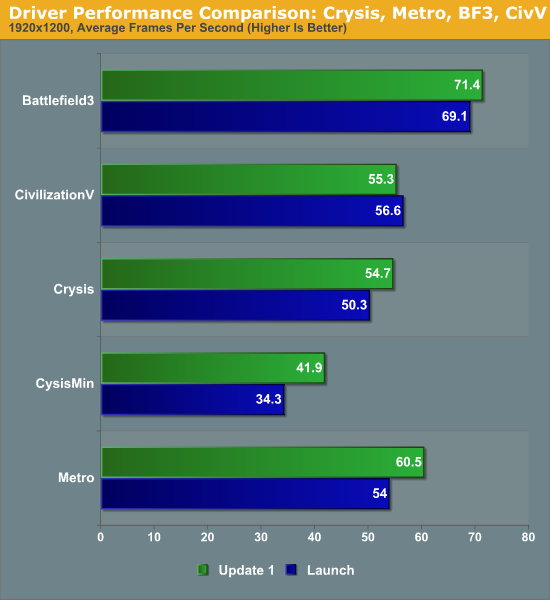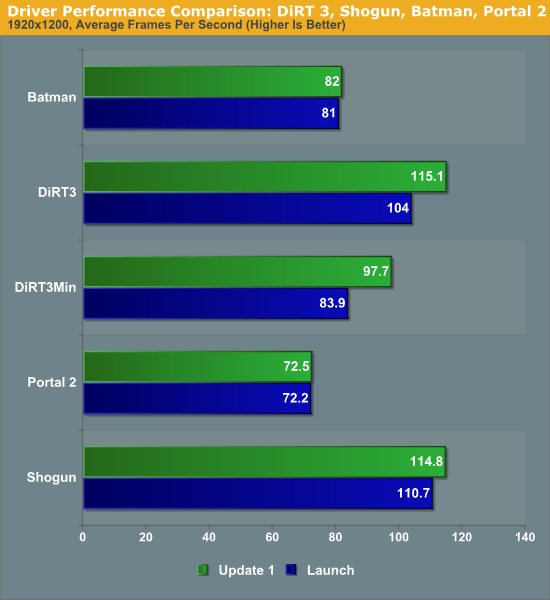AMD Radeon HD 7950 Review Feat. Sapphire & XFX: Sewing Up The High-End Market
by Ryan Smith on January 31, 2012 9:02 AM ESTGetting the Most Out of GCN: Driver Improvements
With the launch of any new architecture there’s still a lot of room for improvement on the part of driver developers, and GCN is no exception. On January 20th AMD released the first driver update for the 7000 Series, which brought with it an interesting mix of bug fixes, new features, and performance improvements. On the feature side AMD enabled support for Analytical Anti-Aliasing and Super Sample Anti-Aliasing for DX10+ games, an overdue feature that we’re very happy to see finally make it to AMD cards. Meanwhile on the performance side the new drivers improved the performance of the 7000 series in several games. Game performance typically rises slowly over time, but as this is one of the first post-launch driver releases, the gains are larger than what we’re used to seeing farther down the line.
To get an idea of where performance has improved and by how much, we reran our entire benchmark suite on the 7970.


As to be expected, at this point in time AMD is mostly focusing on improving performance on a game-by-game basis to deal with games that didn’t immediately adapt to the GCN architecture well, while the fact that they seem to be targeting common benchmarks first is likely intentional. Crysis: Warhead is the biggest winner here as minimum framerates in particular are greatly improved; we’re seeing a 22% improvement at 1920, while at 2560 there’s still an 11% improvement. Metro:2033 and DiRT 3 also picked up 10% or more in performance versus the release drivers, while Battlefield 3 has seen a much smaller 2%-3% improvement. Everything else in our suite is virtually unchanged, as it looks like AMD has not targeted any of those games at this time.
As one would expect, a result of these improvements the performance lead of the 7970 versus the GTX 580 has widened. The average lead for the 7970 is now 19% at 1920 and 26% at 2560, with the lead approaching 40% in games like Metro that specifically benefited from this update. At this point the only game the 7970 still seems to have trouble pulling well ahead of the GTX 580 is Battlefield 3, where the lead is only 8%.










259 Comments
View All Comments
chizow - Wednesday, February 1, 2012 - link
Sorry, but this is incorrect. Nvidia and AMD are direct competitors when it comes to GPUs so relative performance directly influences price.This is why AMD cannot sell CPUs for more than $200. They don't have anything faster than Intel's 10th+ fastest processors (spread over 2-3 generations, its pretty sad actually), so they can't just price Bulldozer at $1000 by slapping an X on it and expect to sell any.
There is a ceiling on the prices they can charge however due to economic and external factors like price elasticity of demand, disposable income, GDP, competing products (consoles etc) so within that construct, AMD and Nvidia have to price their products to make them most attractive to prospective buyers.
They know exactly what % of the market will bite at each price and performance tier using their own gathered market research as well as independent firms like Peddie etc. $400+ is high-end enthusiast, in order to price here, you have to be the top dog, or the 2nd tier. The top dog sets the table for every other GPU, it doesn't matter who makes it.
Historically, this next-gen top dog has shifted the price and performance metric for all next-gen GPUs because the market expects and demands it. That's just progress. Tahiti brings nothing to the table in this regard, its performance is incremental but its pricing just maintains the status quo.
The problem is Tahiti's pricing indicates the GTX 580 was the target it was shooting for, the problem is, they should've been taking aim at Kepler.
JNo - Thursday, February 2, 2012 - link
chizow - the new pirks?TerdFerguson - Tuesday, January 31, 2012 - link
Chizow is right, you guys are wrong. Get over it.Consumer electronics are supposed to get cheaper AND faster at tremendous rates. In failing to improve their price/performance ratio over a couple of generations, AMD has failed. NVidia is failing pretty badly right now, too, but since this is an AMD release, AMD is getting the flack at the moment. If you apply AMD's pricing model to any other consumer electronics product, it becomes very evident that things are very broken. Would you pay $4k for a Ivy Bridge CPU, because IB > SB > Core2 > Core > P4 > P3 > P2 > Pentium > 486 > etc, and a better chip must always command a price premium? Doh, of course you wouldn't.
mdlam - Tuesday, January 31, 2012 - link
Pricing is determined and adjusted based on the law of efficient markets. the 580 is 500 dollars only because people are still willing to pay for it, not because of Chizow's ridiculous theory that companies conspire these fabulous schemes to trick people out of their money. So based on this existing market of people willing to pay 500 dollars for gtx580 performance benefits, AMD is going to TAKE those customers away by giving more for less, or more for more in a linear price/performance scale. It's just how markets work, prices don't revolve around these God-like rules of tier1, tier2, tier3. Guess what, AMD is right, because these cards right now are selling higher than the $550 retail price. They should have priced it at $650!mdlam - Tuesday, January 31, 2012 - link
And there is no flawed pricing model to AMD that would end up with a slippery slope of $4k for an Ivy bridge. Prices = aggregate buying desire of the market. All markets usually hit a ceiling price for an item, no matter what it is. Some people have a high ceiling, some people have a low ceiling, its not anyone's fault, its just the fact of life. Any company, AMD or NVIDIA, or INTEL, will price to sell to people with higher ceilings, and when demand is met, lower price to increase adoption from folks with lower ceilings.chizow - Wednesday, February 1, 2012 - link
Sorry, not in this market.If you think this is OK, there would never be any progress in the semiconductor market. Its not like we're talking cars here where a new model year means a few minor upgrades.
With GPUs, CPUs and any other semiconductor, you expect FASTER performance at the SAME prices or CHEAPER prices. That's called progress.
The law of efficient markets would tell you if you bought a GTX 580 14 months ago, you made the right call. Buying today, you're setting yourself up for some heartache, but more probably, you're kicking yourself for waiting.
Arnir69 - Friday, February 3, 2012 - link
I'm really disappointed with 7950 too, it's a little bit better than 580 but not enough to justify a such a long wait, it's performance is well short of expectation in BF3.hyperdoggy - Tuesday, January 31, 2012 - link
While I'm not in favor of the prices AMD has set for the new cards, you do realize that Nvidia has never prices their cards low right? A quick price check history will show you since the FX day Nvidia has priced their card to sell your kidney. It was the tnt days that Nvidia did a price favor vs their competitors. I bet you my right kidney(i sold my left one for a 8800gtx for $650 day 1 of lunch) that Kepler will be no different, regardless of what its performance will be.I never got the fanboy aspect of things, you see gamers that can calculate min-max fps better than most math majors yet somehow only see red or green when the numbers are laid out right in front of them. I'm shame to say i'm old enough to been around from the voodoo days, i went to Voodoo, Nvidia, Ati, Nvidia, Ati, Nvidia, and now name AMD for more than i can remember. Go for what's best at the time you need an upgrade. Stop making yourself colored hulk when your team doesn't have a product to be competitive.
SlyNine - Tuesday, January 31, 2012 - link
Yea and the 8800GTX kicked stomped the crap out of the competition. This is just a bump up, and kick stomp prices.Plus this is AMD not Nvidia. Where is the 5870, the 9700pro. This is closer to a 5800Ultra or a 2900XT. Of course those cards at least had some real competition in the form of a 8800GTX and 9700pro.
If the 8800GTX and 9700pro would have only increased performance as much as say the 6970 or 580GTX ( compared to their previous cards 5870/480) then the analogy would truly work and the 7970 would basicly be the 2900XT/5800Ultra of its day.
chizow - Tuesday, January 31, 2012 - link
Actually if you look at recent pricing history, you'd see Nvidia has kept their flagship pricing in-line and much lower than what we are seeing here with SI, despite the fact Nvidia had the leading part for that generation in both cases with the GTX 480 and GTX 580.Both of those parts launched at $500 and were faster than AMD's competing same-generation part. If Nvidia did the same as AMD, the 580 would've been priced at $550-600 for that 10-15% performance bump over the 480, but they kept their pricing constant while increasing performance. As I stated earlier, AMD definitely had a hand in this when they undercut the GTX 280 so badly in 2008, but Nvidia did learn their mistake and has not raised the pricing metric since.
Now Nvidia does have a decision to make. If they beat SI with Kepler as expected, they can go with AMD's pricing which will again, make no sense. Or they can stick to their historical price/performance model and make AMD look really bad just as AMD did to them 3 1/2 years ago.